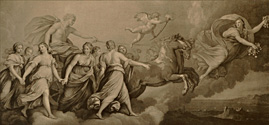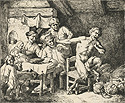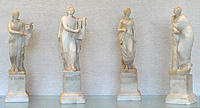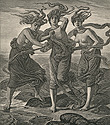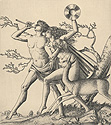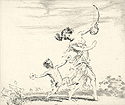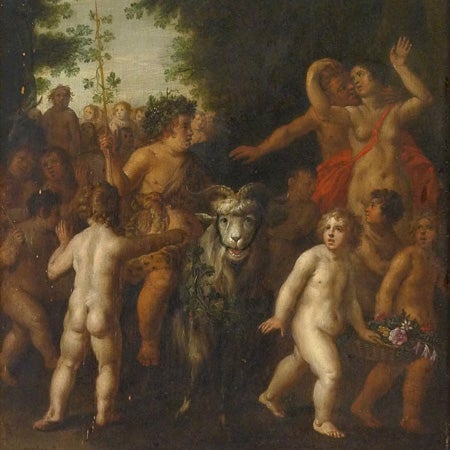
Introduction
The objects presented in this exhibition are populated by figures from Greek and Roman myth, as preserved in the literature of the Classics. Although we may not realize it, images of and references to Classical mythology are still part of our world as vestiges of the culture of antiquity. We see this in fountain statuary, architectural details, in literature, and the performing arts.
In the pre-Christian era, the gods were venerated in temples tended by cults; homes and civic buildings were dedicated to and protected by the respective gods governing those aspects of social life. The Roman poet Ovid is probably the most important source of Classical mythology. His fifteen-book catalogue of the loves and transformations of the gods, The Metamorphoses, had a singular impact on the development of Western art and literature.
The various temperaments, trials, and fates of the gods were instructive to social mores and behavior, and illuminated human frailties such as vanity, greed, idleness and jealousy. In the visual arts, the positive and negative human qualities were codified in the influential emblem book Iconologia by the Italian Cesare Ripa (c. 1560 – c. 1622). In a series of woodcuts, Iconologia proposed an allegorical iconography of the virtues and vices illuminated in the myths of Ovid and other Classical authors. For the next two centuries, Ripa’s book had a tremendous impact on European art and culture.
For wealthy noble families and the monarchy, the myths were the source of the propaganda of self-promotion and divine right, such as Queen Elizabeth I represented as the chaste goddess Diana, or Louis XIV as the sun god Apollo. In this exhibition we find allegorical portraiture together with the legends of the gods depicted in the decoration of palaces and the book arts. Mythological subjects fell out of favor during the Victorian era and were to a large extent replaced by morally instructive genre scenes. The French Symbolists returned to mine the power of myths for their expressive potential, and references to Classical mythology remained a potent source for visual artists throughout the twentieth century.
Bacchanal
Adriaen van Nieulandt, the younger (1587 – 1658)
Oil on panel
375 x 275 mm
This Flemish panel painting depicts the youthful god Bacchus riding a goat, wearing a leopard skin and a garland of grape leaves, two of his traditional attributes. Bacchus was the god of wine, wine-making and revelry, and he was worshipped in the cult of Dionysus (his Roman name) for centuries before the Christian era. Those affiliated with the cult were sometimes buried in elaborate marble sarcophagi decorated with a Bacchic frieze. Adriaen Van Nieulandt was the third generation of a family of Flemish painters. He typically painted multi-figure compositions such as this, based on history, mythology or the Bible. Van Nieulandt created a much larger version entitled the Triumph of Bacchus, now in the Danish National Gallery in Copenhagen. It is possible that Georgetown’s painting formed part of a larger composition that was cut down at some point in time.
Aurora
Unknown engraver, after Guido Reni (1575 – 1642)
Collotype
213 x 437 mm
This collotype engraving reproduces the famous fresco from the Palazzo Rospigiosi-Pallavicini by the Bolognese classicist Guido Reni, who followed painter Annibale Carracci to Rome to work on the ceiling of the Palazzo Farnese (see case W4). Painted on the central hall ceiling of the Casino Dell’Aurora in 1616, Reni’s fresco depicts Apollo driving his chariot preceded by Dawn (Aurora), who symbolically brings light (equivalent with goodness) into the world. Apollo’s chariot is encircled by female figures representing the hours, while the cherub above, bearing a flaming torch, is symbolic of the morning star. The frieze-like compositional format reveals Reni’s inspiration from carvings on antique funerary sarcophagi.
Hercules Resting
Nicolas Mignard (1606 – 1668), after Annibale Carracci
Engraving
190 x 254 mm
Nicolas Mignard, brother of court portraitist Pierre Mignard, travelled to Rome in 1635 under the patronage of the Cardinal Archbishop of Lyon. He resided at the Palazzo Farnese with its Baroque frescoes by Annibale Carracci depicting the loves of the gods in the Gallery and the life of Hercules in the Camerino. The latter was an allegorical allusion to the virtue of the young Cardinal Odoardo Farnese. The central panel of Carracci’s Camerino portrays the Choice of Hercules, with two side panels depicting Hercules Supporting the Globe opposite the Resting Hercules. These represent the Neoplatonic ideal of the two types of life: the active and the contemplative. The figure of Hercules reveals Carracci’s inspiration from the extensive collection of antique statuary that was displayed in the palace at that time.
In 1637, a year after returning to France, Mignard created nine etchings based on Carracci’s Farnese ceiling decorations. In this etching, a reverse of the ceiling painting, Hercules reclines upon the skin of the Nemean lion, surrounded by other symbols of his famous contests: the apples of the Hesperides (beneath his leg), the head of the Arcadian stag, the three-headed dog Cerberus, the Erymanthian boar, and the winged sphinx. In Carracci’s original, a Greek inscription on the plinth below the sphinx reads “Toil is the bringer of sweet rest.”
Apollo and the Cumaean Sibyl
Salvator Rosa (1615 – 1673)
Etching with drypoint
337 x 215 mm
Salvator Rosa, a charismatic painter, etcher, and author of satirical plays, made over 100 copper plate etchings and excelled at representing the human form in that medium. This image depicts the priestess that presided over Apollo’s oracle at Cumae, a Greek colony near Naples (Rosa’s hometown). The Cumaean sibyl was considered the most powerful of all ancient sibyls (or priestesses), and appeared in several classical texts including the Eclogues and Æneid of Virgil, the Metamorphoses of Ovid, and the Satyricon of Petronius. Rosa’s Apollo and the Cumaean Sibyl is among a group of large plate etchings of classical pairs created in Rome, including Ceres and Phytalus, Glaucus and Scylla, and Jason and the Dragon. Rosa’s signature appears on Apollo’s lyre.
Tableaux du Temple des Muses
Cornelis Bloemaert (after drawings by Abraham van Diepenbeeck)
This 1655 volume of lavish mythological imagery contains fifty-eight leaves of engraved plates by the Flemish painter and engraver Cornelis Bloemaert II, after paintings by Abraham van Diepenbeeck (1596-1675). As suggested in the title, the book contains morally didactic scenes representing the virtues and vices as recounted in the most famous fables of antiquity. The author, Michel de Marolles, was a French cleric and translator of the Classics. Here he includes primarily the myths of Ovid, as well as those of Hesiod, Virgil, Aeschylus, and Nonnus, among others. The text is bound in a separate volume, not in Georgetown’s collection.
Les Amours Pastorales de Daphnis et de Chloe
Benoit Audran the Elder (1661 – 1721)
This diminutive French volume of engravings with no text illustrates the classic pastoral poem by Longus (3rd century B.C.) about the platonic love of Daphnis and Chloe, two orphans raised by shepherds on the Greek isle of Lesbos. During the Elizabethan era, Longus’s poem inspired Sir Philip Sydney’s Arcadia and Shakespeare’s comedy As You Like It.
The 1718 book contains twenty-six plates including a frontispiece, engraved by Benoit Audran the elder after original drawings by Philippe II, duc d’Orléans (1674-1723), under the direction of Antoine Coypel, his official court painter. Coypel also provided the design for the frontispiece. The duc d’Orléans was the son of Louis XIV’s younger brother and served as Regent of France from 1715 to 1723 until the majority of the young king Louis XV.
The Union of Painting and Sculpture
Simon Henri Thomassin (1687 – 1741)
Engraving
4232 x 338 mm
This grand allegorical engraving, glorifying the late king Louis XIV, is based on a 1724 painting by Louis de Boullogne the younger. Born to a family of artists, Boullogne was an important painter of church altarpieces, palace interiors and monumental allegories. His commissions included paintings for the cathedral of Nôtre Dame, the chapel and apartments at Versailles, and the chateaux of Trianon, Marly, Meudon, and Fontainebleau. In 1724 he was appointed first painter to the king, and soon thereafter director of the Academy of Painting and Sculpture.
The warrior goddess Minerva (Roman equivalent of Athena) figured prominently in a number of Boullogne’s works as patron of the arts. As such, she was the perfect allegorical counterpart to Louis XIV, himself a major champion of the arts and founder of the French Royal Academy. Here, Minerva bears aloft the portrait of the deceased king. Below them, the seated allegorical figures of Painting on the left and Sculpture on the right are accompanied by their respective attributes. This engraving of Boullogne’s work was Simon Thomassin’s presentation piece to the Academy upon his entrance as a new member. It was also published as the frontispiece to a large volume of engraved portraits of the officers of the French Royal Academy.
Satyr and Peasants
Christian Wilhelm Dietrich (1712 – 1774)
Etching
142 x 170 mm
C.W. Dietrich’s Satyr and Peasants is based on a 1620 painting by the Flemish master Jacob Jordaens, illustrating one of Aesop’s Fables. In this tale by the sixth century B.C. author, a satyr walking together with a man on a cold day asks his companion why he is blowing on his hands, and the man tells him he is warming them. Later on at dinner, the man begins to blow on his food before eating, and when he explains to the satyr that he is cooling the hot food, the satyr gets up to leave, exclaiming that he can no longer be friends with a person who in the same breath blows hot one minute and cold the next. The moral of the story is the duality of human nature.
This etching presents the final scene inside the farmer’s home where the family is seated at dinner and the satyr, in disgust, rises to leave the table. The artist’s signature appears on the wall above the woman’s head. A prominent artist of his day, C.W. Dietrich was court painter to Emperor Augustus III at Dresden, director of the painting school at the Meissen porcelain factory, and professor at the Dresden Hochschule für Bildende Künste (academy of fine arts).
Carved Elephant Tusk
German
Ivory
A fanciful procession of mythological figures is presented on this elephant tusk. Intricately carved in high relief, the scene has an overarching musical theme, with several instruments shown including a lyre, a bagpipe, and a cornu horn with a zoomorphic bell.
Erbach in Germany (where this tusk was likely carved) has been a renowned center of ivory carving since 1769. Count Franz I of Erbach (1754 – 1832) established a guild for ivory carvers in his district after seeing examples of the craft in Austria.
Jupiter change Io en vache pour la derober a la jalousie de Junon
Gabriel Bodenehr (1671 – 1766)
Mezzotint
336 x 412 mm
This mezzotint depicts a scene from Ovid’s Metamorphoses in which Jupiter transforms the beautiful nymph Io into a cow when his wife Juno discovers he has been unfaithful with her. The transformation is intended to disguise the lovely maiden from his vengeful wife, but in the end, Io is transformed back into her human form and re-named Isis. The book of Ovid was translated into a popular edition by the French clergyman and historian abbé Antoine Banier in 1717, and the illustrations to the text were engraved by various printmakers in numerous editions throughout the century. So highly prized, the plates later served as design models for the porcelain painters in the Rococo style at the Meissen porcelain manufactory near Dresden.
Madame Henrietta as Flora
Samuel Arlent Edwards (1862 – 1938), after Jean-Marc Nattier
Color mezzotint
The subjects of these two allegorical portraits are the daughters of Louis XV of France and his polish Queen, Maria Leszczynska. Anne Henriette (1727-52), depicted as the goddess Flora (in blue), had an older twin sister, Louise Elizabeth. The king’s fourth daughter, Marie Adelaide (1732-1800), is depicted here in the guise of Diana (in pink), goddess of the hunt. The original paintings from which these are copied were made by Jean-Marc Nattier, portrait painter at the French court who revived the fashion of portraying noble and royal ladies in the guise of mythological deities while both idealizing their beauty and comparing their virtues to those of a specific Greek goddess.
In 2004 Lauinger Library mounted an exhibition on mezzotint master Samuel Arlent Edwards, who created beautiful color mezzotints based on old master paintings at the turn of the twentieth century. Edwards revived and perfected the technique of coloring each impression by hand on the mezzotint plate, and thus signed each of his impressions: “Engraved and printed in color at one printing without retouching.”
Untitled (Glaucus and Scylla?)
Francesco Bartolozzi (1727 – 1815)
Stipple engraving
357 x 265 mm
Known as the “Engraver of the Graces,” the Florentine-born Francesco Bartolozzi trained in Rome and apprenticed in Venice in the printmaking workshop of Joseph Wagner. In 1764 he accepted a commission to undertake a series of etchings based on drawings by Guercino in the English Royal collection, and was soon named Engraver to the King. Four years later he became a founding member of the Royal Academy.
Bartolozzi enjoyed an illustrious 40-year career in London where he produced engravings inspired by the Italian Renaissance and reproductions of fashionable paintings by his British contemporaries as well as his compatriot Giovanni Battista Cipriani. He is known for reviving and perfecting the 16th century technique of stipple engraving, employed in this mythological scene of a goddess and a triton, or water deity. Using a tool to create a pattern of engraved dots on a metal plate, the artist could achieve varying degrees of shading and depth, and in the case of Bartolozzi, an overall tonal softness that produces the effect of an original crayon drawing.
Eight Muses and Apollo
Unknown
Alabaster
These alabaster statues represent Apollo and the muses with the exception of Clio, the muse of history, missing at the time of donation to Georgetown. According to an 1880 inventory of the art collection drawn up by James Curley, S.J., first director of Georgetown's Astronomical Observatory, the figurines were donated to the Library by “one of the sculptors who came from Italy to work on the Capitol … previous to 1830.” Figures of the muses were popular among travelers of means and may have been inspired by the antique marble statues in the Sala delle Muse in the Vatican. Each of the figures carries its traditional attribute, such as Apollo with his lyre. The other muses and their attributes are identified as follows:
Calliope Muse of epic poetry Writing tablet
Erato Muse of lyric poetry Cithara (a relative of the lyre)
Euterpe Muse of music and elegiac poetry Aulos (a relative of the flute)
Melpomene Muse of tragedy Tragic mask
Polyhymnia Muse of religious poetry Veil
Terpsichore Muse of dance Lyre
Thalia Muse of comedy Comic mask
Urania Muse of astronomy Compass and globe
Temple of Minerva Medica, Rome
Louis Conrad Rosenberg (1890 – 1983)
Drypoint; ed. 75
223 x 338 mm
This ten-sided building from the late Imperial Roman era (4th century A.D.) is actually a nymphaeum and not a temple dedicated to Minerva.
The earliest nymphaea were natural grottoes where nymphs were thought to live; in Rome they usually were connected to the water supply, and served as secular recreational buildings.
Louis Conrad Rosenberg studied architecture at the University of Oregon, and became a prolific etcher of buildings and structures in Europe and America from the 1920s through the 1940s. During the early 1920s he studied at the American Academy in Rome, when he likely made drawings of the Temple of Minerva Medica.
Phorcydes
Gustav Kruell (1843 – 1907), after Elihu Vedder
Wood engraving
181 x 156 mm
The Phorcydes, as a group, are the children of sea gods Phorcys and Ceto. The three shown here are the Graeae (named Deino, Enyo, and Pemphredo) who share one eye and one tooth between them. The Graeae appeared in the film Clash of the Titans as the Stygian Witches who tell Perseus how to kill Medusa—their sister.
Elihu Veder, a major Symbolist painter, book illustrator, and poet, decorated the lobby of the central reading room in the Library of Congress with five allegorical murals, as well as the second floor visitor’s gallery with a magnificent mosaic of Minerva. In 1878 he was commissioned to make a painting of the Phorcydes for a client. This wood engraving published in The American Art Review (Boston: Estes and Lauriat, 1880) with a feature article on Vedder, reproduces that work still owned by a private collector. The Smithsonian’s Archives of American art owns a related drawing made a decade earlier.
Medici Fountain
John W. Winkler (1894 – 1979)
Etching; ed. 50
144 x 147 mm
John W. Winkler was born in Vienna, and came to the United States in 1910 with a forged passport. In 1912 he enrolled in the San Francisco Institute of Art on impulse to learn cartooning in the hopes of making quick money. While his talent was quickly recognized and he was granted a lifetime scholarship at the Institute, the cartoon earnings never materialized and he had to work as a lamplighter. During his lifetime Winkler produced nearly 600 etched plates, hundreds of drawings, jewelry, and 200 hand-carved wooden boxes.
The depicted Leda Fountain (ca. 1807) wasn’t originally part of Paris’s Medici Fountain, which was built in the 17th century. During Baron Haussman’s renovations of the city, street improvements in 1856 caused the Medici Fountain to be moved from its original site. Similar improvements elsewhere in the city meant that the Leda Fountain must also be relocated, and it was then attached to the back of the Medici Fountain in its new location in the Jardin du Luxembourg.
Rites of Spring
Harry Morley (1881 – 1943)
Engraving
After winning a scholarship to the Royal College of Art in 1900, Harry Morley progressed through his training into a career in architecture. He decided to become an artist while on a visit to Italy in 1907 and went to Paris to study painting in 1908. A regular exhibitor at the Royal Academy from 1909, Harry Morley only took up etching in his early forties. He turned to line engraving in the late 1920s, and went on to become a full member of the Royal Society of Painter-Etchers and Engravers in 1931. There is almost always a classical element to be found in Morley’s etchings, and his later printed works are specifically classical in theme.
Satyrs
Stephen Frederick Gooden (1882 – 1955)
Engraving; 89 of 109
Stephen Gooden, together with Harry Morley, was among a small group of British artists who revived the art of line engraving in England following the First World War. Gooden made his first such print in 1923, entitled Absalom, which led to a series of commissioned bookplates. Also that year, Gooden began producing engraved illustrations for the Nonesuch Press up until 1929, including a frontispiece and decorations for five successive volumes of the Nonesuch Press Bible. These were followed by illustrations to The Fables of Lafontaine (Heinemann, 1931), and The Fables of Aesop (Harrap, 1936). The two engravings on this wall, Satyrs and Diana, were created as independent works. The former was a commission of the Print Collector’s Club (of London), and their monogram may be seen on the quiver of arrows beside the seated satyr. The engraving of Diana, goddess of the hunt (see case S4), was produced for the Print Club of Rochester, New York. Gooden’s skill and refined craftsmanship were rewarded with commissions for bookplates for the Royal Library at Windsor Castle (1937) and for Her Majesty Queen Elizabeth (1942).
Arcadia
Troy Sylvanus Kinney (1871 – 1938)
Etching; ed. 170
168 x 198 mm
This fanciful scene of a young satyr and a nymph cavorting while playing music together is inspired by Greek mythology and classical ballet. The American etcher Troy Kinney devoted his output to images of the dance and famous dancers of his time including Anna Pavlova, Adeline Genée and Michel Fokine. A critic and connoisseur, he published an important volume with his wife Margaret West Kinney entitled The Dance: Its Place in Art and Life (1914), exploring the origins of different types of dance world-wide.
Bacchus
Hans Erni (b. 1909)
Lithograph; 6 of 20
530 x 378 mm
This coy Bacchus comes from Hans Erni’s portfolio of color lithographs entitled Ivresse (intoxication), comprising 60 scenes in celebration of wine and viniculture.
History and culture of wine were favored themes of Erni throughout his career; he designed dozens of labels for European wineries including Château Mouton Rothschild. Erni’s fitting personal motto is “Panta Rhei”—everything flows.
Orpheus and Eurydice
Hans Erni (b. 1909)
Etching; 10 of 20
415 x 287 mm
Orpheus lovingly plays and sings for his bride, who gaily dances. Both are oblivious to the poisonous snake who is about to bite and kill Eurydice, forcing Orpheus to pursue her into the underworld and convince Hades to allow her to return.
Fauns
Charles Francis Quest (1904 – 1993)
Opaque watercolor and pencil on illustration board
335 x 243 mm
Dryad Pursued by Centaur
Charles Francis Quest (1904 – 1993)
Opaque watercolor and pencil on illustration board
273 x 378 mm
Charles Quest is best known today as a printmaker, but over his long career he worked in a diverse array of media including mosaic, stained glass, mural painting, and sculpture. Born in 1904, his talent was evident when as a teenager he began copying the works of masters such as Michelangelo on his bedroom walls. He spent some time in Europe after his graduation in 1929, studying at La Grande Chaumière and Academie Colarossi; the two works presented here were created during that period.
These scenes of pursuit combine an Art Deco exuberance of color and decorative pattern with the measured line and flat planes of Greek red-figure pottery, showing Quest’s experimental spirit at this early stage in his career. These illustrations were perhaps intended for publication in a magazine.
Dance of the Centaurs
George Overbury “Pop” Hart (1868 – 1933)
Aquatint and soft-ground etching; ed. 20
327 x 232 mm
To re-create his 1921 watercolor Centaurs and Nymphs as a print, Hart uses grainy softground contours to reproduce the figures’ penciled outlines. Translucent layers of watercolor are translated into broad, subtly-toned areas of aquatint.
With softground, a ground containing soft wax is applied to the plate, and then heavy textured paper is laid over the coated plate. The artist next draws the outlines with a pencil or crayon so that the wax is transferred to the back of the paper, leaving the lines exposed on the plate. When the plate is exposed to acid and then printed, the lines retain the texture of the paper.
In the aquatint technique the plate is treated with a porous ground of rosin which leaves a distribution of tones where the acid has bitten between the grains of rosin. Variation in the application of rosin to the plate and the amount of time the plate is exposed to acid allow for a wide variety of tone and effect.
Pegasus
Salvador Dalí (1904 – 1989)
Published by the Collector’s Guild Ltd., New York
Etching and aquatint; ed. 2,000
175 x 122 mm
According to myth, where the hooves of Pegasus touched the earth, springs arose. Whether these springs were the origin of the Muses, or simply sacred to the Muses like all springs and wells, Pegasus is associated through them with creativity and inspiration: “divine enthusiasm” in the words of Carl Jung, for whom Pegasus was a powerful symbol.
Dalí’s lifelong fascination with Greek mythology—and pursuit of inspiration—produced at least three different renditions of Pegasus.
Orpheus - The Look Back
Prentiss Taylor (1907 – 1991)
Lithograph; ed. 20
400 x 305 mm
In The Look Back Prentiss Taylor takes a crucial instant from the story of Orpheus and Eurydice and magnifies its key elements to extreme dramatic effect. Orpheus’s single, fatal glance is transformed into an abstraction of horror as he realizes that he has just lost Eurydice forever; her graceful figure is already dissolving as the grasping hands of underworld residents pull her back among them.
This print was awarded the Cannon Prize at the 129th annual exhibition of the National Academy of Design (1954), and also the Purchase Award in the 1959 DePauw University First Annual Contemporary American Print Exhibition.
Song of Orpheus
Frank Wright
Deep-bite etching; trial proof
395 x 597 mm
Frank Wright, a Washington, D.C. native and fine art professor at George Washington University, studied at the celebrated Atelier 17 in Paris with experimental printmaker Stanley William Hayter prior to making this extraordinary deep-bite etching, one of his most ambitious in the medium. Here, Orpheus is represented as boy playing an accordion-type instrument in an Arcadian setting filled with all types of animals, enchanted by his divine music. To the left is a reference to Shakespeare’s famous quote from Macbeth (Act V, scene 5, lines 19-28) comparing Life to “a poor player,/ That struts and frets his hour upon the stage.” Thus the seated jester (Life) accompanied by the figure of death wearing a bicorne hat and playing the violin. An avenging angel holding an hourglass and sword looms behind them. The artist with his wife and young daughter are standing to the far right among other mortals.
LuLen Walker · Art Collection Curator
Christen Runge · Assistant Curator
Karen O’Connell · Rare Books
David Hagen · Graphics Production


